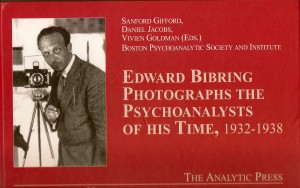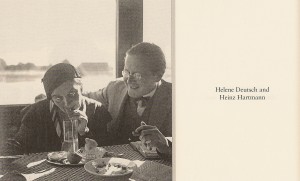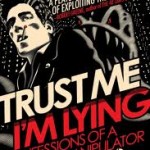Edward Bibring Photographs the Psychoanalysts of His Time
Edward Bibring Photographs the Psychoanalysts of His Time
Edited by Sanford Gifford, Daniel Jacobs & Vivian Goldman
Pub. by The Analytic Press, Psychosozial-Verlag ( 2005), 206 pp.

People who are interested in psychoanalytic theory are usually quite fascinated with the period of time in which these ideas emerged and the people who developed them. Therefore a book of photographs of these people taken by one of them should be a valued treasure. This must have been part of the impetus that led the editors to put together this book which is suppose to be the first of a series of publications by the Boston Psychoanalytic Society and Institute based on material from their archives.
The photographs span the time period between 1932 and 1938. These are photographs taken by Edward Birbring at the 12th IPA Congress in Wiesbaden in 1932, the 13th IPA Congress in Lucerne in 1934, the 14th IPA Congress in Mariendbad in 1936, the Vierlandertagung (which was a meeting of analysts from the four Central European countries) in Budapest in 1937 and the 15th IPA Congress in Paris in 1938 as well as some miscellaneous photographs. Biebring used a Rolleiflex, which is a small camera that allowed candid pictures. It produced a nearly square format and the pictures in the book are all 4 x 4 ½ inches, in black and white of course.
Individual portraits were not the main theme of the book but there were some excellent head shots of Ernest Jones, Max Eitingon, Abraham A. Brill, Sandor Ferenczi and Sandor Rado at the beginning of the book. There also is a self portrait of Edward Bibring which appears on the cover of the book. It would be quite easy to obtain very good individual pictures of other subjects by editing the pictures where there was more than one person in the photograph.
Most of the photographs are groupings of people. While there are some in which all are smiling at the camera or eating food together, most show the subjects engaged in conversation with each other. Perhaps it is my imagination but it appears that they are intensely involved with their discussions. I wish I could know what Anna Freud and Melanie Klein were talking about (perhaps they were discussing their disagreements about psychoanalytic theory).

There were many excellent photographs of various people with Anna Freud and one of her brother Martin Freud, the eldest son, standing by himself. There were no pictures of Sigmund Freud and I can only assume that he did not attend these meetings although I do not know for sure.
Although I did not do a count, some people were in many more pictures than others. Max Eitingon, President of the 12th IPA Congress, and Ernest Jones, President of the 13th and 14th IPA, were in various photographs with many different people. Marie Bonaparte seemed to get around and was in many pictures. Understandably, Grete Bibring, wife of the photographer and also an analyst was amply represented. There were many other well known names and some of their spouses. They were all dressed in the fashion of the times with many of the men wearing vests and hats and the women in long dresses. There was a particularly endearing picture of Helene Deutsch sipping a tall drink with a straw while Heinz Hartmann sits next to her with his arm draped around her chair, smiling at her with a cigar in his hand.

The last 30 pages of the book were short biographical sketches of many of the subjects in the book. This gave the reader not only a thumbnail view of the individuals but reflected the professional interactions of the times. It was very interesting to also see how the spread of the Nazi regime impacted on the people involved in the psychoanalytic movement.

There were many photographs of a woman named Vilma Kovacs about whom I knew nothing and was not included in the biographical sketches. A good book will often stimulate further thinking and I became curious about the role she may have played. I could not find any reference to her in the Ernest Jones or the Peter Gray biography of Freud where just about everyone else in the analytic movement seems to be listed in the index. I did track down information about her with an Internet search that I will summarize below to give an example of the lives and contributions of the extraordinary people who were photographed in this book.
Vilma Kovács-Prosznitz, the Hungarian psychoanalyst, was born at Szeged in Hungary on October 13, 1883 and died in Budapest in May 1940. She was the third daughter of a provincial bourgeois family and her father died while she was still very young, less than six years old. The family found itself destitute, and Vilma was married at the age of fifteen and against her will to a cousin, Zsigmond Székely, who was 20 years older than she. By the age of 19 she was the mother of three children. Alice, the eldest, later married Michael Balint. Vilma contracted tuberculosis and had to spend prolonged periods in a sanatorium. It was there that she met Frédéric Kovács, an architect, whom she married after a difficult divorce that separated her from her children for several years. A serious case of agoraphobia led Vilma into analysis with Sándor Ferenczi. He was quick to spot his patient’s talents and during the 1920s he trained her as a psychoanalyst, making her one of his closest collaborators.
In 1925, Vilma Kovács became head of the training committee. A highly reputed training analyst, she organized the Hungarian Psychoanalytic Association’s clinical seminars and along with Sándor Ferenczi she elaborated the Hungarian training method: the candidate’s analyst supervises the candidate’s first case on the couch. Vilma Kovács’s work related almost totally to training. Practically every Hungarian analyst of her time frequented her clinical seminars at one time or another. More specifically, she analyzed Imre Hermann and Géza Róheim. She published only five articles, but one of them, Training Analysis and Control Analysis (1935), is a classic of psychoanalytic literature and has been translated into several languages. In another article, Examples of the Active Technique, dating from 1928, she provides a remarkably clear presentation of this technique that her mentor, Sándor Ferenczi, had just introduced, illustrating it with several examples. Through her clear-mindedness, her remarkable clinical sense, and her organizational skills, Vilma Kovács left a profound mark on the Hungarian school of psychoanalysis. – Summarized from the Psychoanalysis Dictionary
I have two suggestions for any future editions of this book or similar types of publications of historical photographs. It would be useful to have an index so that particular people of interest could be easily located. Also it would be helpful to have an accompanying DVD of digitalized photographs so that when we write about these people in the future we can to pull up these wonderful photographs and continue to share these images with future generations.













